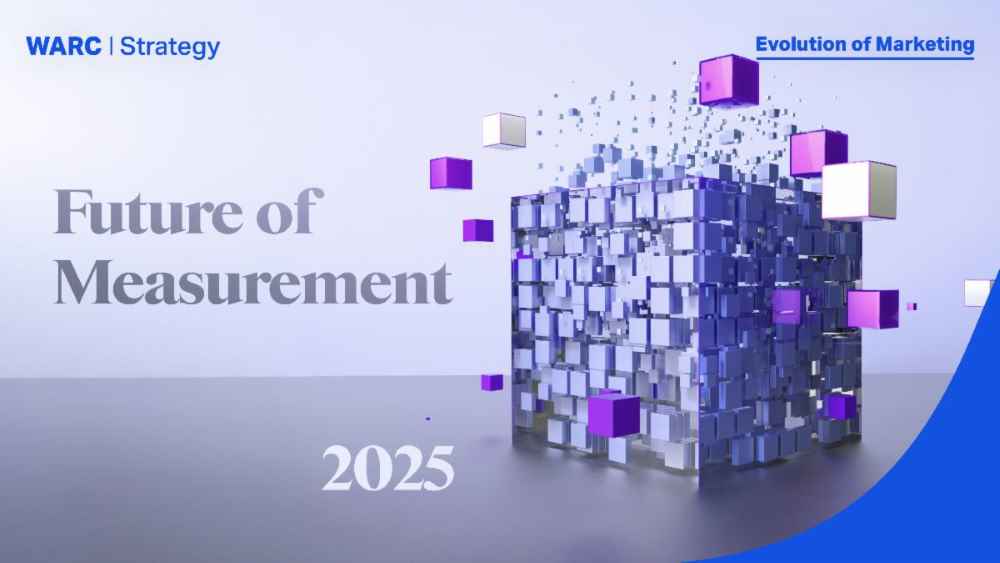
The Future of Measurement 2025, part of WARC’s Evolution of Marketing programme, highlights emerging trends in media and creative measurement
8 May 2025 – As measurement continues to evolve, WARC, the global authority on marketing effectiveness, has today released The Future of Measurement 2025, a report that explores the latest emerging trends in media and creative measurement. It focuses on three key areas: the growth of marketing experiments, the price measurement gap, and the rise of AI-powered creative testing.
Paul Stringer, Managing Editor Research and Insights, WARC, says: “Once considered the preserve of more advanced advertisers, the next 12 months in marketing measurement will be defined by a growing democratisation of tools and methods. However, while AI tools, in particular, bring new speed and scale to measurement, advertisers still lack a complete framework for understanding advertising return on investment.
“With this report we aim to provide clarity on the latest advancements in measurement techniques by sharing insights from both WARC and external research, as well as equipping marketers with takeaways to put into practice.”
Key trends set to shape the measurement landscape over the next 12 months are:
Marketers using experiments doubles, from 18% to 36%
The number of marketers using experiments to measure marketing effectiveness has risen significantly, doubling from 18% to 36%, over the past year.
Considered key for understanding advertising effectiveness, experiments enable marketers to examine causality, or the incremental effects of advertising. They also encourage the exploration of new approaches, channels and creative ideas.
Underused for many years, the widespread availability of incrementality testing tools on social and retail media platforms is driving an uptick in adoption across the industry.
However, experiments are not without limitations. Advertisers are advised to conduct experiments with careful preparation by setting out clear hypothesis, identifying success metrics and choosing the right experimental design. Platform lift tests still lack control, transparency, and cross-channel performance comparison capabilities. Experiments work best in combination with other methodologies and should be embedded within a broader learning agenda to maximise their value.
Brands profit from price measurement
Advertisers are becoming more cognisant of the long-term effects of brand on price – and are investing in bespoke measurement solutions to prove it.
There is ample evidence showing that strong brands have more pricing power, with consumers willing to pay higher prices for their products and services, and less likely to stop buying when prices increase.
Pricing power is the greatest driver of profitability for businesses, meaning, advertising’s impact on price is key to the ongoing argument for long-term brand investment.
However, when measuring the price effects of advertising, most of the models used by advertisers capture advertising effects across a period of three or four years, when pricing effects typically take much longer to play out.
As more marketers appear to be taking pricing effects seriously, pricing power is likely to become even more important if US-led global trade tariffs force companies into raising prices for consumers.
At a time when marketing budgets are under near-constant pressure, marketers are advised to track price as a KPI or get involved in pricing decisions; track pricing effects over time to calculate advertising’s payback; and avoid treating marketing investment as a short-term cost rather than a long-term investment capable of generating future economic benefits.
AI-driven creative testing is rising but human touch remains vital
Creativity might be the single most important lever of advertising effectiveness at marketers’ disposal, but it is also one of the most difficult to quantify.
AI technologies are beginning to transform how advertisers measure and optimise creative assets at speed and scale, giving companies access to granular insights and learnings about creative effectiveness across media, devices and channels.
While AI enables cost-effective testing at scale, it is recommended to maintain human testing alongside AI tools, especially for ‘hero’ campaign assets. This hybrid approach will help mitigate AI testing limitations, such as evaluating new ideas or thinking.
The integration of creative data in marketing mix modelling (MMM) means advertisers can now model the impact of creative using econometric techniques. As an emerging area of measurement, guidance and best practices are still in development. But it opens the door to a clearer understanding of the role that creativity plays in driving commercial outcomes for brands.
Read a sample report of The Future of Measurement here. WARC subscribers can read the report in full. A WARC podcast on the topic will be available from 15 May.
The insights for The Future of Measurement report are based on a combination of exclusive data from WARC and external research studies and reports. It is part of WARC Strategy’s Evolution of Marketing, series of in-depth forward-looking reports on the marketing discipline through evidence-based insights and emerging trends, technologies, and other drivers of change.



